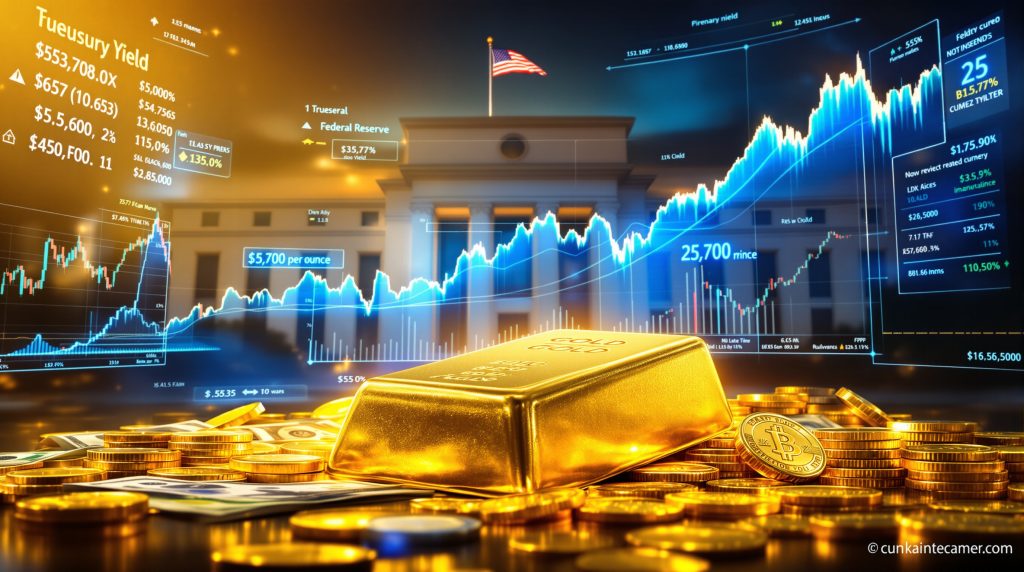Gold Market Dynamics: Understanding Price Movements After Fed Rate Cut The Federal Reserve's decision to lower interest rates by 25 basis points on September 17, 2025, created significant volatility in the gold market. While gold initially surged to a new all-time high analysis of $3,707.57 per ounce immediately following the announcement, the precious metal subsequently retreated as market dynamics shifted. The Initial Rally and Subsequent Pullback Gold's response to the Federal Reserve's rate cut followed a classic market pattern of anticipation and adjustment. Immediately after the announcement, spot gold reached an unprecedented high of $3,707.57 before experiencing a 1.2% decline as investors began taking profits. By session's end, prices settled at $3,660.75 per ounce, down 0.8% for the day, demonstrating the market's quick reassessment of the Fed's messaging. This price action exemplifies the "buy the rumor, sell the news" behavior that frequently characterizes gold markets during significant monetary policy shifts. The initial enthusiasm gave way to a more measured response as traders digested the full context of the Fed's decision. Technical indicators suggested the market had become overextended, with gold's 14-day relative strength index (RSI) remaining above 70—a level typically considered overbought territory. Despite this short-term correction, gold's year-to-date gains of nearly 40% have significantly outperformed major equity indices, reflecting strong underlying momentum. Why Did the Dollar Strengthen Despite Rate Cuts? The market's reaction to Fed Chair Jerome Powell's press conference proved pivotal for both the dollar and gold prices. Powell's Less Dovish Than Expected Commentary While Powell acknowledged growing concerns about labor market conditions during his press conference, his overall tone was more balanced than many anticipated. He specifically noted that "labor demand has softened, and the recent pace of job creation appears to be running below the break-even rate needed to hold the unemployment rate constant." However, Powell maintained a dual focus on managing both inflation risks and growth concerns. This balanced approach contrasted with his more accommodative messaging at the Jackson Hole economic symposium in August, where markets had interpreted his comments as signaling a more aggressive easing cycle. Dollar Index Performance Following Powell's remarks, the U.S. dollar index gained 0.2%, demonstrating currency traders' interpretation that the Fed's guidance was less accommodative than markets had anticipated. This strengthening dollar created immediate headwinds for gold prices, as the two assets typically exhibit an inverse relationship. The dollar's resilience highlighted the complex interplay between monetary policy expectations and currency valuations, with gold caught in the crosscurrents of these shifting market dynamics. What Factors Continue to Support Gold's Long-Term Outlook? Despite the short-term pullback, multiple fundamental drivers continue to support gold's structural bull market. Monetary Policy Environment The Fed's September rate cut marks the beginning of its first easing cycle since December 2024, creating a more favorable environment for non-yielding assets like gold. Lower interest rates reduce the opportunity cost of holding gold, which doesn't pay interest or dividends. Financial markets continue to price in additional rate cuts through 2026, suggesting the monetary policy backdrop will remain supportive for precious metals. The World Gold Council notes that historically, gold has performed well during Federal Reserve easing cycles, particularly when cuts occur amid broader economic uncertainty. Institutional Price Targets and Forecasts Major financial institutions have been revising their gold price forecast upward. Deutsche Bank recently raised its forecast to $4,000 per ounce, a significant increase from their previous $3,700 target set in April. According to their analysts, persistent geopolitical tensions and central bank purchasing are likely to maintain upward pressure on prices. Institutional investors have steadily increased their gold allocations throughout 2025, with exchange-traded fund (ETF) inflows accelerating in recent months. This institutional demand provides an important foundation for sustained price strength. Geopolitical and Economic Uncertainty The ongoing trade tensions between major economies have heightened demand for safe-haven assets. Current geopolitical conflicts in Eastern Europe and the Middle East continue to support risk-hedging strategies that typically favor gold. Additionally, economic growth concerns in several major economies have boosted gold's appeal as a portfolio diversifier. While inflation has moderated from peak levels, uncertainty about its future trajectory remains despite central bank efforts to achieve price stability. How Are Gold Market Technicals Influencing Trading Strategies? The technical picture for gold reveals both short-term vulnerabilities and long-term strength. Short-Term Technical Considerations Gold experienced significant profit-taking after reaching overbought conditions, making it vulnerable to further short-term corrections. Trading volumes increased substantially during the volatile post-Fed session, indicating high market engagement. Key support levels around $3,600 and $3,500 are being closely monitored by technical analysis insights and market participants. The 50-day moving average currently provides a technical floor that could limit downside potential during consolidation phases. Market Sentiment Analysis Frank Monkam, head of macro trading at Buffalo Bayou Commodities, observed that gold's pullback reflected profit-taking rather than fundamental weakness. According to Monkam, the metal was "caught in the spillover sentiment from other asset classes including equities and bonds as investors booked profits following the expected Fed rate cut." He further noted that gold remains "vulnerable to these types of short-term corrections" due to crowded positioning, suggesting the potential for consolidation before the next sustained move higher. What's Driving Gold's Exceptional Performance in 2025? Gold's nearly 40% gain year-to-date has been fueled by multiple factors converging simultaneously. Central Bank Purchasing Trends Central banks have continued their aggressive gold accumulation strategy that began in 2023. This institutional buying represents a fundamental shift in reserve management philosophy, with many central banks diversifying away from traditional reserve currencies. Emerging market central banks have been particularly active buyers, with several institutions citing the need to reduce dependence on any single reserve currency. According to the World Gold Council's quarterly reports, central bank purchases have provided a solid floor for prices throughout 2025. Investment Flows and Market Sentiment Exchange-traded fund (ETF) inflows have accelerated significantly during 2025, reversing the outflows observed in previous years. Retail investor participation has broadened considerably, with many seeking inflation protection and portfolio diversification. Institutional allocations to gold have increased as portfolio managers reassess the metal's role in modern investment strategies. Gold's outperformance relative to major equity indices and alternative assets has further attracted momentum-driven investment flows. Historical Context of Gold's Performance Gold has now surpassed its inflation-adjusted peak from 1980, representing a significant psychological milestone for market participants. Unlike previous bull markets, the current uptrend features broader participation across investor categories and geographic regions. Price momentum has accelerated despite periodic corrections, suggesting strong underlying demand. The fundamental drivers supporting this rally—including monetary policy, geopolitical tensions, and institutional buying—appear more sustainable than in previous gold bull markets. How Does Gold Compare to Other Asset Classes in 2025? Gold's outperformance relative to other investments has been a defining market theme this year. Comparative Performance Metrics Asset Class YTD Performance (%) Volatility (%) Correlation to Gold Gold +39.8% 18.2% 1.00 S&P 500 +24.6% 22.1% 0.21 US Treasuries +5.3% 8.7% 0.35 Bitcoin +31.2% 48.3% 0.18 Commodities +8.7% 19.6% 0.44 This performance comparison highlights gold's strong returns with moderate volatility compared to other major asset classes. Particularly notable is gold's low correlation with traditional financial assets, underscoring its value as a portfolio diversifier. Gold's Role in Modern Portfolios Traditional 60/40 equity/bond portfolios have benefited significantly from gold allocations in 2025. The metal's ability to provide diversification benefits during periods of market stress has enhanced portfolio efficiency and reduced overall volatility. Institutional investors have increased their strategic gold investment allocations, moving beyond tactical positioning to incorporate the metal as a core portfolio component. Research from several major investment banks suggests optimal gold allocations of 5-10% for balanced portfolios in the current macroeconomic environment. What Should Investors Watch for in Gold Markets? Several key indicators and events will likely influence gold's trajectory in the coming months. Key Price Levels and Technical Markers The recent high of $3,707.57 represents immediate resistance that must be overcome for the rally to resume. Support levels around $3,600 and $3,500 are being closely monitored as potential entry points during corrections. The 50-day moving average provides an important technical floor that has contained previous pullbacks. Trading volumes at key price points indicate potential market pivots, with high-volume tests of support typically providing more reliable signals. Upcoming Economic Indicators Inflation reports will significantly influence rate cut expectations and gold's price trajectory. Labor market data could accelerate or slow the Fed's easing cycle, particularly following Powell's comments about softening employment conditions. GDP growth metrics will impact safe-haven demand, with weaker readings typically supporting gold prices. Consumer sentiment indicators affect jewelry demand forecasts, which remain an important component of overall gold consumption. Potential Market Catalysts Further Federal Reserve policy announcements will continue to drive market volatility. Geopolitical developments, particularly in regions with significant commodity production, could trigger safe-haven buying. Changes in ETF investment flows serve as important sentiment indicators for the gold market. Central bank purchasing patterns, especially from emerging economies, provide fundamental support for prices. How Are Gold Mining Companies Positioned in This Environment? The gold mining sector has responded differently to the gold price rally than in previous cycles. Production Economics and Margins Current all-in sustaining costs (AISC) for major gold producers average approximately $1,250-1,350 per ounce, creating exceptional profit margins at current gold prices. This cost structure, combined with gold prices above $3,600, has generated record free cash flow for many producers. Unlike previous bull markets, mining companies have maintained stronger capital discipline, focusing on margin expansion rather than aggressive production growth. This approach has enhanced the sector's financial health and sustainability. Capital Allocation Strategies Dividend increases have become widespread throughout the gold mining sector, with many companies implementing progressive dividend policies. Share buyback programs have accelerated as companies prioritize returns to shareholders. Merger and acquisition activity remains selective and disciplined, with companies focusing on high-quality, long-life assets rather than pursuing growth at any cost. Exploration budgets have increased moderately, reflecting a balanced approach to organic growth opportunities. FAQs About Gold's Recent Performance Why did gold prices fall after the Fed cut rates? Gold initially rallied to record high surge following the Fed's rate cut announcement but subsequently declined as the dollar strengthened. This occurred because Fed Chair Powell's comments were less dovish than expected, suggesting a measured approach to future rate cuts rather than an aggressive easing cycle. The market had already priced in the 25-basis-point cut, leading to profit-taking once the actual announcement occurred. Will gold reach $4,000 per ounce in 2025? Several major financial institutions, including Deutsche Bank, have raised their gold price forecasts to $4,000 per ounce. While price predictions are inherently uncertain, the combination of monetary policy easing, geopolitical tensions, and strong investment demand provides fundamental support for higher prices. However, investors should recognize that short-term corrections are likely along the path to new price levels. How does gold perform during rate-cutting cycles? Historically, gold has performed well during Federal Reserve rate-cutting cycles, particularly when cuts occur amid economic uncertainty. Lower interest rates reduce the opportunity cost of holding non-yielding assets like gold and often coincide with currency devaluation concerns. Analysis of previous easing cycles shows gold typically outperforms both equities and fixed income during periods of monetary accommodation. What's driving central bank gold purchases? Central banks continue to diversify reserves away from traditional currencies, particularly the US dollar. This trend reflects concerns about currency debasement, geopolitical tensions, and the desire to reduce dependence on any single reserve currency. Emerging market central banks have been particularly active buyers as they seek to increase financial sovereignty and hedge against geopolitical risks. How does gold's performance compare to silver in 2025? While gold has gained nearly 40% year-to-date, silver has shown even stronger performance with gains exceeding 45%. The gold-to-silver ratio has decreased from approximately 87:1 at the beginning of the year to around 78:1 currently, indicating silver's outperformance during this precious metals bull market. Silver's industrial applications, combined with its monetary characteristics, have driven this outperformance during periods of both economic growth and inflation concerns. Ready to Capitalise on the Next Gold Price Movement? Discover potentially market-moving mineral announcements before they make headlines with Discovery Alert's proprietary Discovery IQ model, which analyses ASX announcements in real-time to identify significant gold and other mineral discoveries. Visit our discoveries page to see how major mineral discoveries have historically generated substantial returns for early investors.

Comprehensive Guide to Blasting Operations at Loulo-Gounkoto Mine
Discover how advanced explosive methods, safety protocols, and technologies drive



